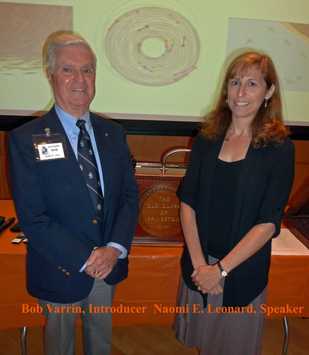September 19, 2012
Flocks and Fleets:
Collective Motion in Nature and Robotics
Naomi E. Leonard
Edwin S. Wilsey Professor of Mechanical & Aerospace Engineering, Princeton University
Flocks and Fleets:
Collective Motion in Nature and Robotics
Naomi E. Leonard
Edwin S. Wilsey Professor of Mechanical & Aerospace Engineering, Princeton University
Minutes of the Second Meeting of the 71st Year
President Ruth Miller called the September 19th meeting to order at 10: 15. It was the second meeting of the 71st year of the Old Guard. Jo Johnson and Charles Roger introduced guests and George Cody noted the 20th anniversary conference of the Community Without Walls to be held at the Frist Center on Oct. 5th.
Owen Leach read the approved minutes of the Sept. 12 meeting. Bob Varrin then introduced our speaker Naomi Leonard, the Edwin S. Wiley Professor of the Department of Mechanical and Aerospace Engineering at Princeton University. Professor Leonard has a long list of credentials that include a MacArthur Genius Grant.
Her lecture was titled "Flocks and Fleets: Collective Motion in Nature and Robotics."
Professor Leonard started her talk by saying that the plan for the day consisted of three goals:
Goal (2) as we remember, goal (2) said it was useful to study collective motion of both natural and robotic groups. Natural groups can navigate, move about, forage, react to predators and reproduce. (Robots can't do this yet).
We need to define what goes on in nature so that we can design our robotic networks to efficiently perform their tasks. We must explain enabling mechanisms in natural groups, and equate this with defining mechanisms for robotic groups.
Goal (3) is to impress upon us the importance of feedback in any system. Professor Leonhard put up a slide to diagram this process.
Owen Leach read the approved minutes of the Sept. 12 meeting. Bob Varrin then introduced our speaker Naomi Leonard, the Edwin S. Wiley Professor of the Department of Mechanical and Aerospace Engineering at Princeton University. Professor Leonard has a long list of credentials that include a MacArthur Genius Grant.
Her lecture was titled "Flocks and Fleets: Collective Motion in Nature and Robotics."
Professor Leonard started her talk by saying that the plan for the day consisted of three goals:
- Give us an insight on how complex motion of groups can emerge from a collection of relatively simple individuals.
- Illustrate how it is fun and useful to study collective motion of both natural and robotic groups as part of the same story.
- Impress on us the importance of feedback in any system. Feedback is the responsive decision making of individuals (natural or robotic) to what they can sense, and how mathematical models and methods can be used to understand these acts.
Goal (2) as we remember, goal (2) said it was useful to study collective motion of both natural and robotic groups. Natural groups can navigate, move about, forage, react to predators and reproduce. (Robots can't do this yet).
We need to define what goes on in nature so that we can design our robotic networks to efficiently perform their tasks. We must explain enabling mechanisms in natural groups, and equate this with defining mechanisms for robotic groups.
Goal (3) is to impress upon us the importance of feedback in any system. Professor Leonhard put up a slide to diagram this process.
SENSE Measure behavior Behavior----------- |
APPLY RULE Determine response SYSTEM-------------------- |
ACT Implement response input |
Using feedback and common mathematical frameworks, Professor Leonard described efforts to understand natural groups (fish) that move in patterns that seem highly choreographed and then put this understanding into designs for robotic devices that work with unprecedented efficiency.
The devices in this case, are submersible gliders that pump water in and out to change their buoyancy. This allows them to rise and fall through the ocean as they glide forward. A fleet of gliders recently deployed in Monterey Bay, CA to sample the waters for salinity, temperature, plankton depths, current direction etc. The search pattern and control system was designed here by Professor Leonard and her crew.
After a short Question and Answer period the meeting was adjourned at 11:30
Respectfully submitted,
George Vaughan
The devices in this case, are submersible gliders that pump water in and out to change their buoyancy. This allows them to rise and fall through the ocean as they glide forward. A fleet of gliders recently deployed in Monterey Bay, CA to sample the waters for salinity, temperature, plankton depths, current direction etc. The search pattern and control system was designed here by Professor Leonard and her crew.
After a short Question and Answer period the meeting was adjourned at 11:30
Respectfully submitted,
George Vaughan

